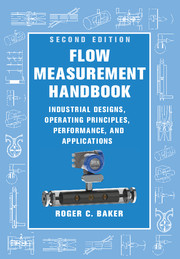Book contents
- Frontmatter
- Dedication
- Contents
- Preface
- Acknowledgements
- Nomenclature
- 1 Introduction
- 2 Fluid Mechanics Essentials
- 3 Specification, Selection and Audit
- 4 Calibration
- 5 Orifice Plate Meters
- 6 Venturi Meter and Standard Nozzles
- 7 Critical Flow Venturi Nozzle
- 8 Other Momentum-Sensing Meters
- 9 Positive Displacement Flowmeters
- 10 Turbine and Related Flowmeters
- 11 Vortex Shedding, Swirl and Fluidic Flowmeters
- 12 Electromagnetic Flowmeters
- 13 Magnetic Resonance Flowmeters
- 14 Ultrasonic Flowmeters
- 15 Acoustic and Sonar Flowmeters
- 16 Mass Flow Measurement Using Multiple Sensors for Single-Phase Flows
- 17 Multiphase Flowmeters 508
- 18 Thermal Flowmeters
- 19 Angular Momentum Devices
- 20 Coriolis Flowmeters
- 21 Probes for Local Velocity Measurement in Liquids and Gases
- 22 Verification and In Situ Methods for Checking Calibration
- 23 Remote Data Access Systems
- 24 Final Considerations
- References
- Main Index
- Flowmeter Index
- Flowmeter Application Index
16 - Mass Flow Measurement Using Multiple Sensors for Single-Phase Flows
Published online by Cambridge University Press: 05 August 2016
- Frontmatter
- Dedication
- Contents
- Preface
- Acknowledgements
- Nomenclature
- 1 Introduction
- 2 Fluid Mechanics Essentials
- 3 Specification, Selection and Audit
- 4 Calibration
- 5 Orifice Plate Meters
- 6 Venturi Meter and Standard Nozzles
- 7 Critical Flow Venturi Nozzle
- 8 Other Momentum-Sensing Meters
- 9 Positive Displacement Flowmeters
- 10 Turbine and Related Flowmeters
- 11 Vortex Shedding, Swirl and Fluidic Flowmeters
- 12 Electromagnetic Flowmeters
- 13 Magnetic Resonance Flowmeters
- 14 Ultrasonic Flowmeters
- 15 Acoustic and Sonar Flowmeters
- 16 Mass Flow Measurement Using Multiple Sensors for Single-Phase Flows
- 17 Multiphase Flowmeters 508
- 18 Thermal Flowmeters
- 19 Angular Momentum Devices
- 20 Coriolis Flowmeters
- 21 Probes for Local Velocity Measurement in Liquids and Gases
- 22 Verification and In Situ Methods for Checking Calibration
- 23 Remote Data Access Systems
- 24 Final Considerations
- References
- Main Index
- Flowmeter Index
- Flowmeter Application Index
Summary
Introduction
The measurement of mass flow, a fundamental requirement for any fluid, has been an elusive goal due to the problems of developing a suitable flowmeter. Despite this, the availability of mass flowmeters has increased greatly over the past 25 years. This is partly due to the increasing value of products (Hall 1990), but it is also due to an increasing realisation that volumetric flow measurement is often inappropriate. In addition, the advent of the Coriolis flowmeter has stimulated engineers to find other mass flowmeters. General reviews of mass flowmeters were given by Sproston, Johnson and Pursley (1987), Betts (1990) and Medlock and Furness (1990).
Mass flow measurement is sometimes categorised as direct (true) or indirect (inferential). However, it may be useful to allow a few more than two categories.
a. True (direct) mass flow measurement by a single instrument is rare. It appears that to achieve it we need to use one of the fundamental acceleration laws. We can do this by creating:
• the force (or torque) resulting in a linear (or angular) acceleration (Chapter 19 describes an example) or
• the force that produces Coriolis acceleration (Chapter 20).
b. Fluid-dependent thermal mass flow measurement uses the temperature rise resulting from heat addition but is affected by other parameters such as the specific heat of the fluid (Chapter 18).
c. Multiple differential pressure flowmeters used in a dedicated system (Section 16.2) depend on the nonlinearity of the flowmeter equation.
d. Indirect (inferential) mass flow measurement combines volumetric flow rate or momentum flow rate with a density measurement (Section 16.3). (An alternative is to combine volumetric and momentum flow measurements.)
e. Multiphase flow measurement almost always requires multiple measurements (Chapter 17).
In this edition of the book, I have included a brief survey of mass flowmeters for multiphase flow in Chapter 17.
Multiple Differential Pressure Meters
Before turning to the one method that is commercially available, for completeness we shall look at two methods that have been suggested but, to my knowledge, have not been used commercially.
Twin Venturi System
The twin Venturi system depends on the use of two identical Venturi meters (or other differential pressure devices) that are arranged in parallel balanced paths as shown in Figure 16.1.
- Type
- Chapter
- Information
- Flow Measurement HandbookIndustrial Designs, Operating Principles, Performance, and Applications, pp. 501 - 507Publisher: Cambridge University PressPrint publication year: 2016



